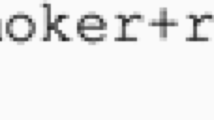Abstract
In epidemiology, the concepts of “biologic” and “statistical” interactions have been the subject of extensive debate. We present a new approach to biologic interaction based on Rothman’s original (Am J Epidemiol, 104:587–592, 1976) discussion of sufficient causes. We do this in a probabilistic framework using competing risks and argue that sufficient cause interaction between two factors can be evaluated via the parameters in a particular statistical model, the additive hazard rate model. We present empirical conditions for presence of sufficient cause interaction and an example based on data from a liver cirrhosis trial illustrates the ideas.


Similar content being viewed by others
References
Aalen OO (1980) A model for non-parametric regression analysis of counting processes. In: Klonecki W, Kozek A, Rosiński J (eds) Mathematical Statistics and Probability Theory. Lecture Notes Statistics vol 2. Springer, Berlin pp 1–25
Aalen OO (1989) A linear regression model for the analysis of life times. Stat Med 8:907–925
Andersen PK, Borgan Ø, Gill R, Keiding N (1993) Statistical models based on counting processes. Springer, New York
Andersen PK, Geskus RB, de Witte T, Putter H (2012) Competing risks in epidemiology: possibilities and pitfalls. Int J Epidemiol 41:861–870
Andersen PK, Skovgaard LT (2010) Regression with linear predictors. Springer, New York
Borgan Ø, Langholz B (1997) Estimation of excess risk from case-control data using Aalen’s linear regression model. Biometrics 53:690–97
Clayton D, Hills M (1993) Statistical models in epidemiology. Oxford University Press, Oxford
Cox DR (1958) Planning of experiments. Wiley, New York
Gerstman BB (2003) Epidemiology kept simple: an introduction to traditional and modern epidemiology. Wiley, New York
Greenland S, Poole C (1988) Invariants and noninvariants in the concept of interdependent effects. Scand J Work Environ Health 14:125–129
Grobbee DE, Hoes AW (2009) Clinical epidemiology: principles, methods, and applications for clinical research. Jones & Bartlett, Sudbury
Hernan M, Robins J (2014) Causal Inference. To appear 2014 from Chapman and Hall/CRC. Available at: http://www.hsph.harvard.edu/faculty/miguel-hernan/causal-inference-book/
Khoury MJ, Beaty TH, Cohen BC (1993) Fundamentals of genetic epidemiology. Oxford University Press, Oxford
Koopman JS (1981) Interaction between discrete causes. Am J Epidemiol 113:716–724
Martinussen T, Scheike TH (2006) Dynamic regression models for survival data. Springer, New York
Perme Pohar M, Stare J, Estève J (2012) On estimation in relative survival. Biometrics 68:113–120
Rod NH, Lange T, Andersen I, Marott JL, Diderichsen F (2012) Additive interaction in survival analysis: use of the additive hazards model. Epidemiology 23:1–5
Rothman KJ (1976) Causes. Am J Epidemiol 104:587–592
Rothman KJ (1986) Modern epidemiology, 1st edn. Little, Brown, Boston
Rothman KJ (2012) Epidemiology: an introduction, 2nd edn. Oxford University Press, Oxford
Rothman KJ, Greenland S (1998) Modern epidemiology, 2nd edn. Lippincott, Williams & Wilkins, Philadelphia
Rothman KJ, Greenland S, Lash TL (2008) Modern epidemiology, 3rd edn. Lippincott Williams & Wilkins, Philadelphia
Rothman KJ, Greenland S, Walker AM (1980) Concepts of interaction. Am J Epidemiol 112:467–470
Skrondal A (2014) Much ado about interactions. Epidemiology 25:723–726
Susser ES (2006) Psychiatric epidemiology: searching for the causes of mental disorders. Oxford University Press, Oxford
VanderWeele TJ (2009) Sufficient cause interactions and statistical interactions. Epidemiology 20:6–13
VanderWeele TJ, Robins JM (2008) Empirical and counterfactual conditions for sufficient cause interactions. Biometrika 95:49–61
VanderWeele TJ, Robins JM (2012) Stochastic counterfactuals and stochastic sufficient causes. Stat Sin 22:379–392
Webb P, Bain C, Pirozzo S (2005) Essential epidemiology: an introduction for students and health professionals. Cambridge University Press, Cambridge
Author information
Authors and Affiliations
Corresponding author
Rights and permissions
About this article
Cite this article
Andersen, P.K., Skrondal, A. A competing risks approach to “biologic” interaction. Lifetime Data Anal 21, 300–314 (2015). https://doi.org/10.1007/s10985-015-9318-z
Received:
Accepted:
Published:
Issue Date:
DOI: https://doi.org/10.1007/s10985-015-9318-z




